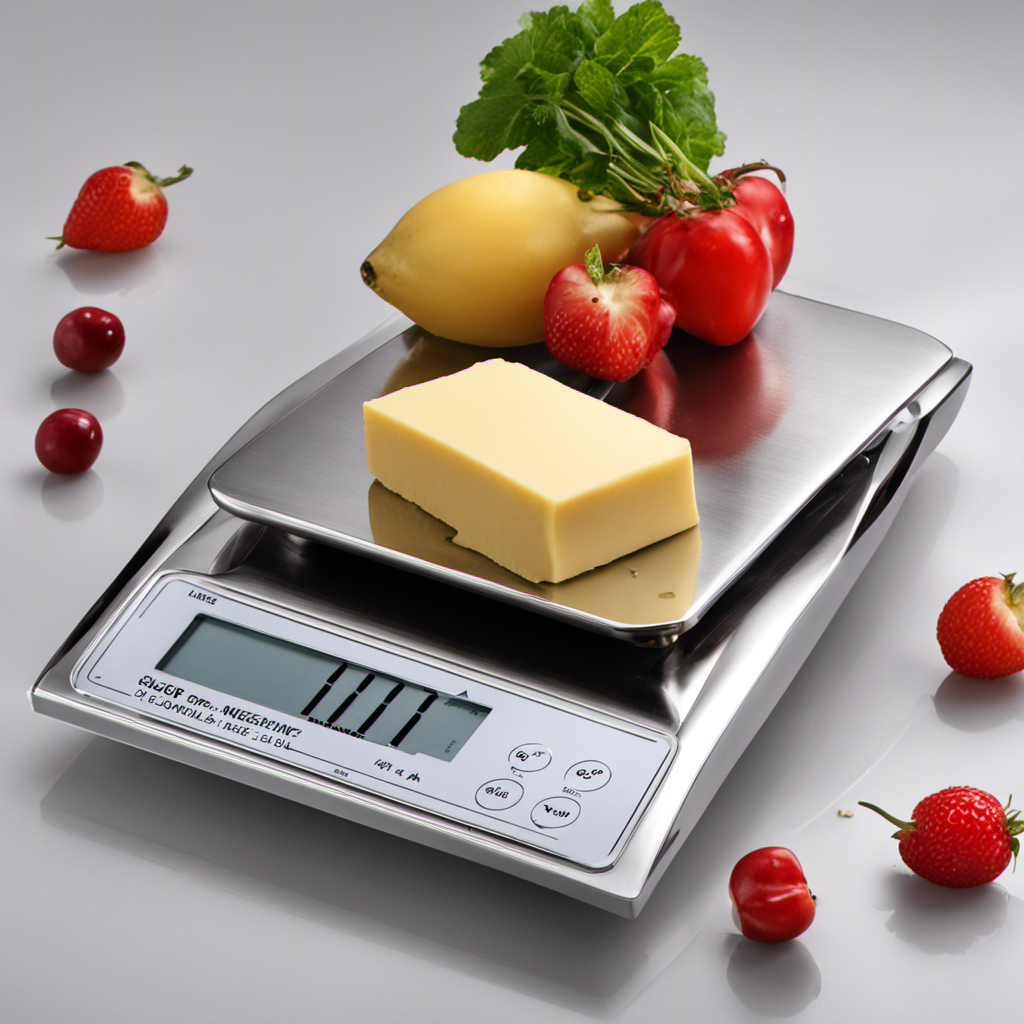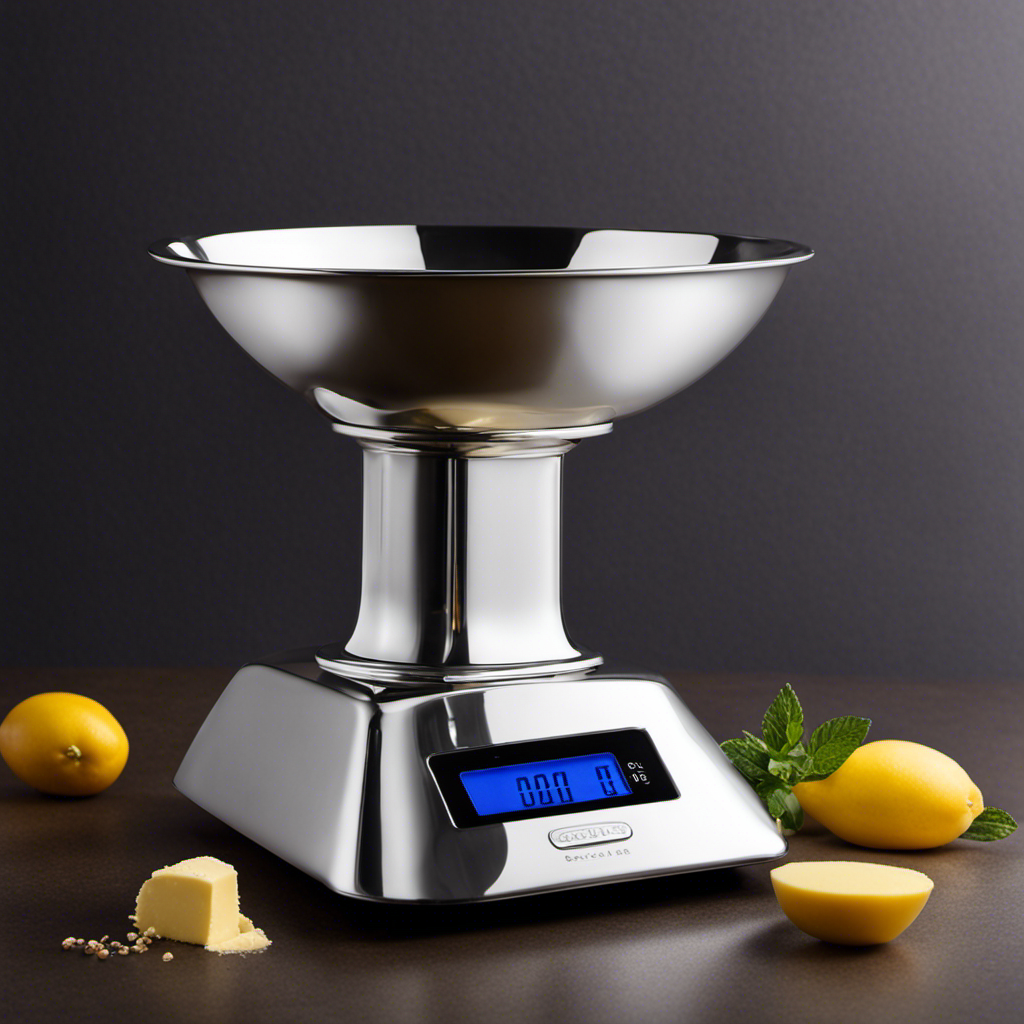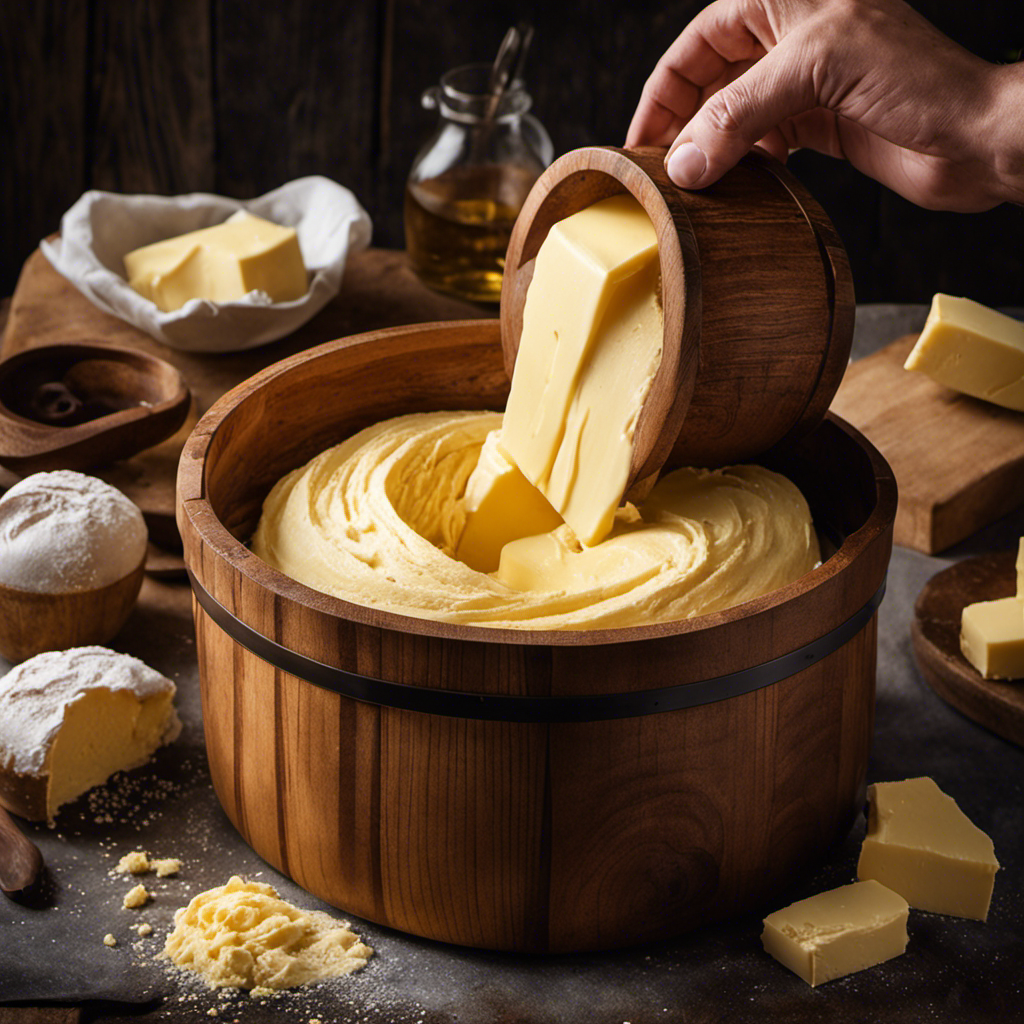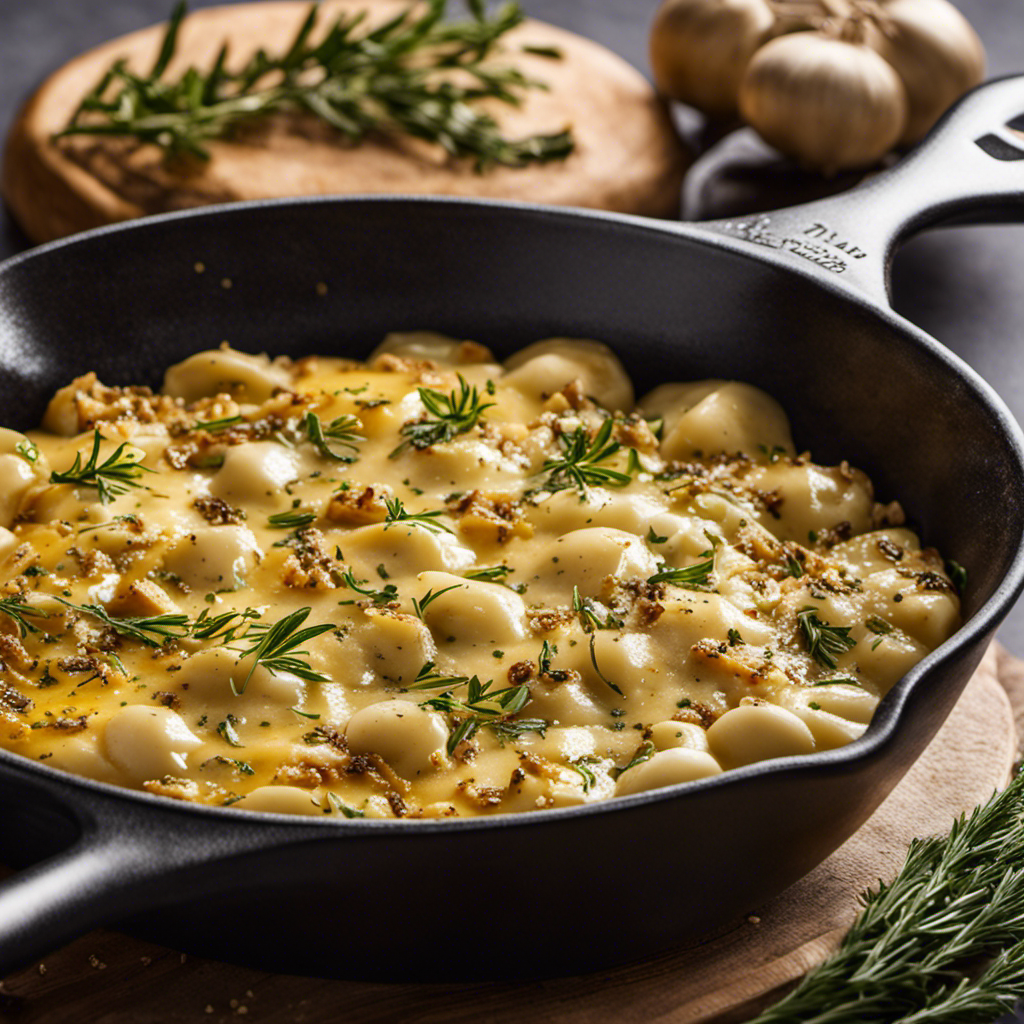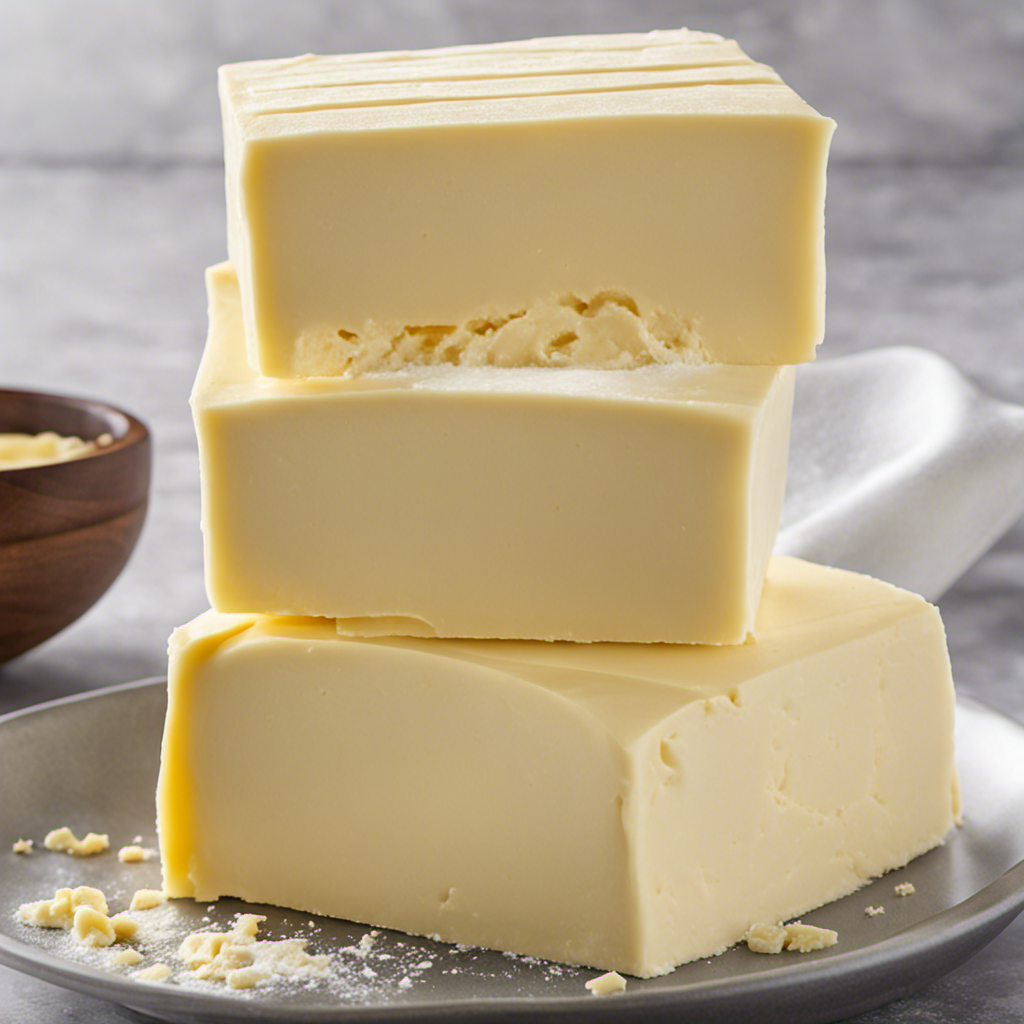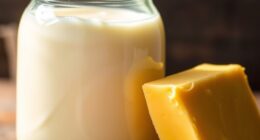Do you ever find yourself wondering how much 150 grams of butter actually is? Well, wonder no more! In this article, we will delve into the world of butter measurements and give you all the information you need to confidently measure and use 150 grams of butter in your recipes.
From converting grams to tablespoons, to finding the perfect substitute, we’ve got you covered. So let’s dive in and unlock the secrets of 150 grams of butter!
Key Takeaways
- 150 grams of butter is equivalent to around 5.29 ounces.
- Butter adds flavor, richness, and moisture to dishes.
- Use a kitchen scale for precise measurement of butter.
- Butter substitutes include coconut oil, avocado, and plant-based margarine.
What Is 150 Grams of Butter
150 grams of butter is equivalent to approximately 1 and 1/3 sticks of butter.
When it comes to butter, there are various types of butter brands available in the market, each with its own unique characteristics. Some popular brands include Land O’Lakes, Kerrygold, and Plugrá.
Butter is not only used as a spread but also plays a crucial role in cooking techniques. It adds flavor, richness, and moisture to dishes. Butter can be used for sautéing, frying, baking, and even as a base for sauces. Its versatility makes it a staple in the kitchen.
Now, let’s delve into the conversion of grams to tablespoons, which will give us a better understanding of how to measure butter accurately in different recipes.
Converting Grams to Tablespoons: Butter
Converting grams to tablespoons can be helpful when you want to measure your ingredients accurately. When it comes to butter, 1 gram is approximately equal to 0.067 tablespoons. To make it easier for you, here is a table that shows the conversion of grams to tablespoons for different amounts of butter:
| Grams (g) | Tablespoons (tbsp) |
|---|---|
| 10 | 0.67 |
| 50 | 3.34 |
| 100 | 6.69 |
Now, let’s move on to other ingredients. If you want to convert grams to tablespoons for oil, the conversion is slightly different. 1 gram of oil is approximately equal to 0.05 tablespoons. And if you are looking to convert grams to cups for sugar, 1 gram is equal to 0.004 cups. Remember, these conversions are approximate and may vary slightly depending on the density of the ingredient.
How to Measure 150 Grams of Butter
To measure out the desired amount of butter, you can simply use a kitchen scale. Measuring butter accurately is important in recipes to ensure the correct ratio of fat and moisture.
While some recipes may provide alternative measurements for butter, such as tablespoons or cups, using a kitchen scale is the most precise method. Butter can vary in density, so relying on volume measurements can lead to inconsistent results.
A kitchen scale allows you to measure the exact weight of butter needed for your recipe, ensuring accuracy and replicability.
Now that you understand the importance of measuring butter accurately, let’s move on to the next section about converting 150 grams of butter to ounces.
Butter Conversion: 150 Grams to Ounces
If you’re wondering how to convert grams to ounces when measuring butter, you’re in the right place.
The grams to ounces ratio for butter is approximately 1 gram to 0.035 ounces.
This means that if you have 150 grams of butter, it would be equivalent to around 5.29 ounces.
Grams to Ounces Ratio
You can easily find the grams to ounces ratio by dividing the weight in grams by 28.35. This ratio is used to convert the weight of an ingredient from grams to ounces.
In baking, it is important to have precise measurements, especially when it comes to butter. Butter is commonly measured in grams or ounces, depending on the recipe.
To convert grams to ounces, you simply divide the weight in grams by 28.35. For example, if you have 150 grams of butter, you would divide 150 by 28.35 to get approximately 5.29 ounces.
This conversion is useful when following recipes that call for specific measurements of butter in grams or ounces.
Converting Butter Measurements
When measuring butter, it’s important to know the grams to ounces ratio for precise conversions. Converting butter measurements can be a bit tricky, especially if you are used to working with ounces or tablespoons.
To convert grams of butter to ounces, you need to divide the weight in grams by 28.35. This will give you the equivalent weight in ounces. For example, 150 grams of butter equals approximately 5.29 ounces.
It’s also worth noting that different brands of butter may have slightly different densities, which can affect the conversion ratio. Therefore, it’s recommended to use a reliable brand of butter for accurate measurements.
Now that you know how to convert butter measurements, let’s explore some delicious recipes that use 150 grams of butter.
Recipes Using 150 Grams of Butter
There’s a variety of delicious recipes you can make with just 150 grams of butter. Butter adds richness and flavor to dishes, making them more delectable. Here are some creative ways to incorporate butter into different dishes:
- Butter Cookies: Whip up a batch of buttery cookies, perfect for tea time or dessert.
- Garlic Butter Shrimp: Sauté succulent shrimp in a garlic butter sauce for a delightful seafood dish.
- Buttercream Frosting: Use butter to make a silky smooth buttercream frosting, ideal for decorating cakes and cupcakes.
These recipes demonstrate the versatility of butter and how it enhances the taste and texture of various dishes.
However, if you prefer to use butter substitutes, there are alternatives available. Let’s explore some butter substitutes for when you don’t have 150 grams of butter on hand.
Butter Substitutes for 150 Grams
If you’re looking for butter alternatives or vegan butter options to replace the 150 grams of butter in your recipes, there are several options available.
One popular choice is coconut oil, which has a similar texture and flavor to butter.
Another option is avocado, which is rich and creamy, making it a great substitute for butter in baking.
For a plant-based option, you can try using margarine made from vegetable oils. Look for brands that are labeled as vegan or dairy-free.
Additionally, there are commercially available vegan butter options made from plant-based ingredients that mimic the taste and texture of traditional butter.
With these alternatives, you can still achieve the desired taste and texture in your recipes, even without using butter.
Now that you know about butter substitutes, let’s move on to some tips for buying and storing 150 grams of butter.
Tips for Buying and Storing 150 Grams of Butter
To ensure freshness, make sure you check the expiration date before purchasing and store it in the refrigerator.
Here are some tips for buying and storing 150 grams of butter:
- Keep it in its original packaging or transfer it to an airtight container to prevent absorption of odors from other foods in the fridge.
- Place the butter on a shelf away from strong-smelling items like onions or garlic.
- If you want to freeze butter for longer storage, wrap it tightly in plastic wrap or place it in a freezer bag.
When it comes to measuring butter accurately, keep in mind that 150 grams of butter is equivalent to approximately 1 and 1/3 sticks or 10 tablespoons.
To measure it precisely, use a kitchen scale or refer to a conversion chart. This will ensure that you have the right amount of butter for your recipes.
Conclusion
So there you have it, now you know all there is to know about 150 grams of butter. Whether you’re converting it to tablespoons, measuring it out, or looking for recipes that use this amount, you’re well-equipped with the information you need.
Remember, ‘A little butter makes everything better!’ Don’t forget to consider butter substitutes if you’re looking for a healthier option.
And when it comes to buying and storing your butter, always keep freshness and quality in mind.
Happy cooking!
